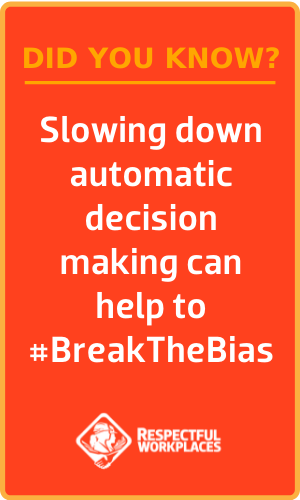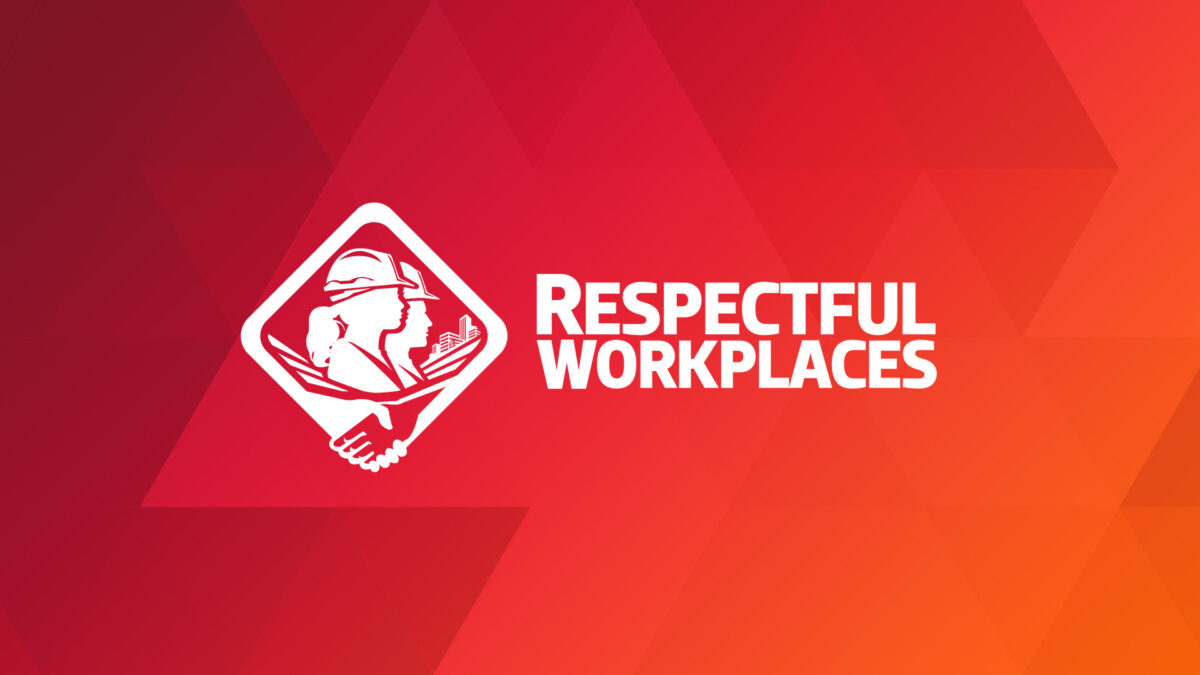Does your organization #BreakTheBias by slowing down automatic decision making in people processes?

This year, the theme for International Women’s Day on March 8 is “#BreakTheBias.” International Women’s Day is a global day celebrating the social, economic, cultural, and political achievements of women, and calls for action for gender parity. The key to “breaking the bias” is eliminating bias, stereotypes, and discrimination.
Many organizations around the world are working to address bias, stereotypes, and discrimination toward women, yet progress is slow. In its 2021 Global Gender Gap Report, the World Economic Forum found that only 58% of the gender gap in Economic Participation and Opportunity has been closed. It remains the second-largest of the four key gender gap metrics and the Forum estimates that it will take another 267.6 years to close the gap at the current rate of progress.
What can organizations do to address bias, stereotypes and discrimination to help achieve gender parity?
The root of the difficulty in reaching gender parity lies not only in identifying how bias, stereotypes, and discrimination may be influencing people processes, but also in re-working those systems to interrupt or reduce gender bias.
To be human is to be biased. We are exposed to incredible amounts of information every day and our conscious brain cannot make sense of all of that information. This leads us to use mental shortcuts, primarily in the form of categories stored in our unconscious mind that allow us to make quick, automatic decisions. Unfortunately, this information is frequently full of stereotypes and misinformation that create unintended biases.
The automatic, quick decisions that relate to people processes, such as comments about whether an individual has potential, or in a formal process for choosing among equally qualified candidates, are especially prone to bias and stereotypes. Our conscious mind works more slowly than our unconscious mind, so it often influences quick automatic decisions.
How can leaders help to reduce bias in decision making?
To reduce the influence of bias and stereotypes on automatic decisions, leaders can temporarily slow down decision making by inserting questions or steps that cause them and others to reflect on their assumptions.
There are two related methods that leaders can use to #BreakTheBias in decision making:
1. Slow down your own automatic decision making in informal people processes.
In a 2015 study by the Canadian Association of Women in Construction, tradeswomen reported that the top three forms of discrimination they experienced were “being treated differently from male colleagues,” “important work given to a male colleague instead of a female,” and “being given work below competence level.”
These findings may reflect the result of unconscious bias toward women in non-traditional roles. If allocating work is done informally and “on-the-spot,” unconscious bias can easily influence decisions. According to Daniel Kahneman in his book, “Thinking, Fast and Slow,” we often rely on “System 1 Thinking:” automatic judgments that stem from associations stored in our memory.
Instead of making automatic decisions, slowing down your thinking process and being aware of how bias and stereotypes may be influencing your decisions can be an effective method for interrupting bias. This is “System 2 Thinking:” inserting steps into your thinking process that cause you to challenge your assumptions.
2. Slow down automatic decision making in formal retention and advancement processes.
In a 2021 study, researchers Laura Kray and Margaret Lee found that early on in their careers, men’s and women’s jobs often take on different characteristics. In their study of 2,000 business school graduates, they found that men, on average are almost immediately given more people to supervise and lead larger teams than women, even when they are at the same level of the hierarchy. Male managers quickly gain larger “spans of control” than female managers at the same organization level, which results in higher compensation and a quicker trajectory to senior management positions.
The researchers found that retention and advancement processes were embedded with stereotypes about the ability of women to lead large teams. In systems of recruitment, retention and advancement decisions are frequently based on old stereotypes and automatic assumptions. The result is that bias and stereotypes influence a series of decisions, and the bias becomes systemic.
Leaders and managers can use their power and influence to re-work people processes to include measures that interrupt unconscious bias and stereotypes. These measures should result in “System 2 Thinking” that cause those involved to temporarily slow down their decision-making, challenge assumptions or expand their perspective.
These process changes might include:
• structured behavioural interviews built around proven job competencies, free of gender bias and stereotypes
• hiring decisions for key positions or certain levels made by a panel that includes women from different levels within the organization, and with anonymous input
• rigorous performance reviews conducted by a diverse group of leaders committed to ensuring equal opportunities for women
Leaders and managers have a key role to play in creating an organization that is free of bias, stereotypes, and discrimination. Organizations have difficulty reducing systemic bias because it works unconsciously and is embedded in systems of decisions. However, leaders can temporarily slow down automatic decision making by inserting questions or steps that can help them and others to #BreakTheBias.
Leaders and managers who are committed to reducing bias and stereotypes in their organizations could consider participating in any or all of the BuildForce Respectful Workplaces online tools. They provide an understanding of bias and stereotypes, how they affect workplaces, and the steps that leaders and managers can take to create a more inclusive workplace.
The BuildForce Respectful and Inclusive Workplace Toolkit provides a suite of tools based on the proven practices of respectful and inclusive organizations:
- Online Self-Assessment Tool
- Policy Framework and Implementation Guide
- Working in a Respectful and inclusive Workplace online course
- Introduction to Understanding Systemic Racism – A Guide for Leaders and Managers online course
For more info:
- Canadian Association of Women in Construction. CAWIC Level Best Needs Assessment Report. November, 2015. See https://cawic.ca/about/level-best.
- Donovan, Mason and Mark Kaplan. The Inclusion Dividend, 2nd Ed. DG Press, New Hampshire, U.S., 2019.
- Kray, Laura and Lee, Margaret. “The Pay Gap for Women Starts with a Responsibility Gap.” The Wall Street Journal. Saturday/Sunday, October 16-17, 2021.
- Ross, Howard J. Everyday Bias. Rowman & Littlefield, London, U.K. 2020.
- Soll, Jack B., Katherine L. Milkman and John W. Payne. “Outsmart Your Own Biases.” Harvard Business Review, May, 2015.
Read from the beginning. Click here to start at Part 1.
What can an effective Respectful and Inclusive Workplace Program deliver?
- Become an employer of choice – attract, retain, and advance top talent from all sources of labour
- Unlock collaboration and innovation – create high-performing teams through diversity of thought and experience
- Build your brand – your organization will gain a competitive edge as a leader and innovator
Get started today!
The BuildForce Canada Online Respectful and Inclusive Workplace Toolkit includes:
- the Respectful Workplace Online Self-Assessment Tool to assist organization leadership in assessing their current situation and identifying where they may need to make changes
- the Respectful Workplace Policy Framework and Implementation Guide to assist organizations in creating and implementing a policy that supports a respectful and inclusive workplace
- the Respectful Workplace Online Training Course to train workers on how to create and support a respectful and inclusive workplace
- the online course Introduction to Understanding Systemic Racism: A Guide for Leaders and Managers
All the resources you need to create and support a respectful and inclusive workplace!

Respectful and Inclusive Workplaces
